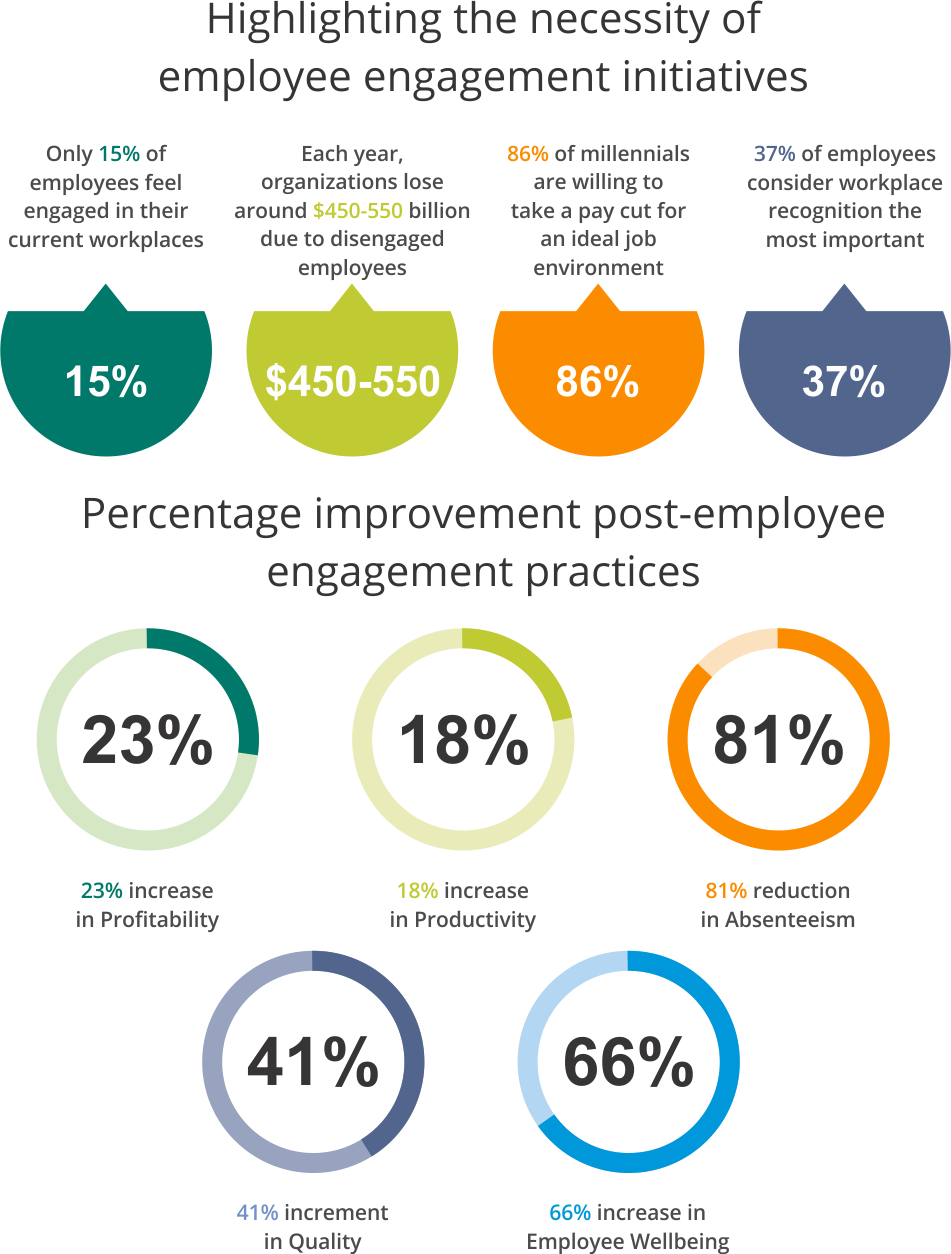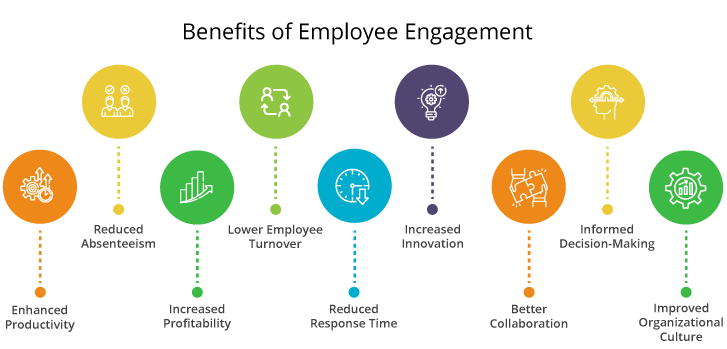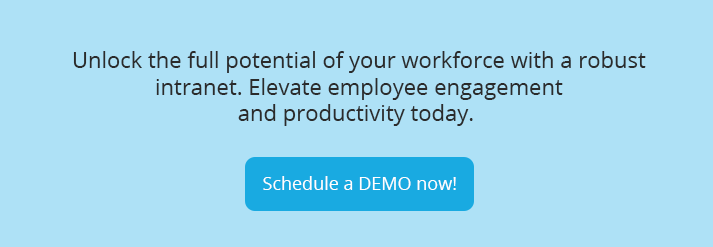
Why is Employee Engagement Important? Discover the Top 9 Benefits of an Engaged Workforce
“When people are financially invested, they want a return. When people are emotionally invested, they want to contribute.”
The above words are perfect to illustrate the benefits of employee engagement. Being a buzzword for modern businesses, employee engagement is a concept that refers to the connection that employees feel for their workplace. So, why is it crucial to have emotionally invested employees in your organization rather than financially invested ones? Does it impact your organization’s bottom line and efficiency?
A recent Gallup study suggested that organizations with highly engaged employees have 21% higher profitability as well as 17% higher productivity than organizations with disengaged employees. Well, here is a comprehensive blog that covers the top 9 benefits of employee engagement and how employee engagement platforms help you get the most out of your engaged workforce.
Understanding employee engagement
The operational needs of modern service and knowledge-oriented industries have stimulated a significant shift in the nature of both work and workplaces. Today’s business problems arising out of a highly competitive market with the impacts of globalization demand something more than the traditional command-and-control approach that signified a transactional relationship between the employees and the organization.
Certainly, bringing employees to the center stage and making them integral to the internal communication channels has helped them align with the organization’s goals and objectives. Modern businesses emphasize employees’ well-being, recognition, morale, and involvement, which can be summed up in one common term, i.e., employee engagement. Now, why is employee engagement important?
Simply put, employee engagement reflects the employees’ willingness to interact with their workplace, understand their priorities, and contribute to the organization’s development. The increase in employee engagement rates positively impacts productivity, profitability, efficiency, and more. Let’s discuss in detail the importance of employee engagement in the workplace and how you can utilize the employee engagement platform to maximize its benefits.

Top 9 Benefits of Employee Engagement
1. Better internal communication
Effective internal communication is crucial to maintaining the information flow within the organization. It positively impacts employees’ performance, conflict resolution, knowledge sharing, and informed decision-making.
Internal communication relies on how open your employees are to access and grasp the information, either circulated by the management or by their coworkers. Indeed, an engaged workforce is more likely to participate in problem-solving, share ideas and feedback freely, and contribute to better decision-making.
However, both employee engagement and internal communication are interlinked, creating a mutually reinforcing cycle that fuels efficiency in the entire system. By communicating key news, announcements, and timely updates on projects and events to employees through interactive media formats, you have a higher chance of creating an engaged workforce.
2. Employee recognition and lesser workplace stress
Various employee engagement practices followed by organizations significantly impact employee recognition. For instance, appreciating employees for their achievements and celebrating their success, or sending them wishes on their birthdays and anniversaries, makes them feel recognized by the organization as well as by their coworkers.
What is it about being recognized that motivates employees?
Employees feel valued and appreciated when they or their efforts are recognized, eventually stimulating their sense of belongingness towards the organization. Additionally, offering a collaborative environment to your employees where they can interact with their peers and share their ideas and feedback promotes a culture of appreciation that ultimately leads to lesser workplace stress.
3. Promotes information and knowledge sharing
Employee engagement efforts, when combined with modern workplace technologies like an intranet, make an ideal recipe for knowledge and information sharing within the organization. For instance, other than documents, the experience of senior employees and subject-matter experts have the most significant share in an organization’s intellectual assets. Indeed, better-connected employees feel a sense of inclusivity that generates trust for their coworkers, ensuring active knowledge transfer irrespective of the organizational silos.
However, there are other aspects besides this. Engaged employees with access to the organization’s intellectual assets, whether documents, policies, guidelines, or technical manuals, feel empowered to share knowledge with newly recruited employees. They also freely participate in common discussion forums and community groups and are more likely to contribute to polls, surveys, and feedback, fostering knowledge capturing as well as knowledge sharing.

4. Increases productivity and operational efficiency
Workplace productivity signifies the amount of work performed by employees in a given period. The above Gallup survey suggests that emotionally involved employees align more with the organization’s goals than those involved financially. However, the ability to establish an emotional connection with coworkers is not the only factor contributing to this process.
It also involves how an employee engages with the digital infrastructure and the workplace. Ensuring the accessibility of the right information easily, eliminating redundant and manual workflows, and improving workplace collaboration are core parts of the employee engagement strategy. As a result, employees are able to complete daily tasks efficiently, remain motivated, and spend time on more important tasks, thus improving their overall productivity.
5. Better employee retention and reduction of absenteeism
Employee turnover rates and absenteeism are modern indicators of the workforce’s health. The most common reasons employees leave their jobs are feeling unrecognized, experiencing workplace stress, or not being able to grow professionally. A recent SHRM survey suggested that only 29% of employees felt satisfied with the available professional development opportunities at their workplace, resulting in greater turnovers.
However, an engaged workplace where employees can access knowledge, communicate openly, and freely showcase their ideas and skills offers them a sense of purpose to stay and contribute to organizational goals. Furthermore, creating a collaborative platform with knowledge-sharing abilities and adequate recognition and appreciation of employees’ skills and achievements can help you retain talent and create a committed workforce.
6. Enhances workplace collaboration
Enhanced collaboration is another factor explaining the importance of employee engagement in the workplace. Undoubtedly, improved workplace collaboration and effective teamwork depend on the employees’ ability to work in teams and express their ideas freely. An engaged workforce shares common goals, vision, and responsibilities and is likelier to take collective initiatives, ensuring healthy team dynamics.
A digital workplace facilitating a collaborative environment helps employees collaborate on documents, projects, and tasks. With a range of features like document sharing, version control, co-authoring, and easy 1:1 meetings and group discussions, it reduces the need for manual approvals and mitigates communication breakdown. Surely, it addresses the decision-making flaws and information silos faced by the organizations.
7. Promotes innovation and creativity
Innovation and creative problem-solving are the driving forces for identifying flaws and improving key business processes. An open and transparent environment with uninterrupted access to resources, clear insights into goals and objectives, and robust internal communication are essential to stimulating creativity.
An engaged workforce, despite having different viewpoints, has one thing in common, i.e., the ability to collaborate and brainstorm together to reach creative solutions. Employee engagement platforms offer a centralized space to exchange ideas and connect with your team irrespective of location, bridging the gap between necessary collaboration and idea generation.
8. Alignment with organizational goals
Another importance of employee engagement is that you get a workforce willingly committed to achieving the organization’s goals and objectives. Organizations can effectively convey their objectives to employees in multiple interactive formats using employee engagement platforms and provide them with adequate resources to achieve the same. Also, employees familiar with an organization’s objectives and work culture have a clear idea of the bigger picture they are involved in and how working collectively can help them achieve smaller targets in time.
9. Strategic importance of employee engagement
Among the many benefits of employee engagement, it also helps organizations gain an extra edge over their competitors. Having a motivated, aligned, and engaged workforce not only helps you achieve your targets but also maintains the quality of service and customer satisfaction, enabling you to outperform your competition. Furthermore, employee engagement platforms, by streamlining processes, collaboration, and communication within the organization, set an ideal stage to successfully implement your business strategies. Certainly, with a robust digital infrastructure, you get a connected, flexible, scalable, and secure environment necessary to stay competitive in the rapidly changing market.
BizPortals 365: Promoting employee engagement through an intranet
The concept of employee engagement represents a psychological and emotional connection of employees with their coworkers and the workplace itself. However, leveraging the benefits of employee engagement relies solely on how organizations create an environment that fosters an engaged workforce. Despite the workplace technologies available in the market, only 36% of employees feel engaged, lowering the productivity and operational efficiency of the organization.
BizPortals 365, a SharePoint-based intranet with robust capabilities to streamline processes, documents, projects, and teams, has helped organizations to successfully outline and implement their employee engagement strategy. Offering a collaborative environment that suits even a hybrid workplace, BizPortals 365 provides department and employee-specific sites, document management, workflow automation, and a range of productivity tools, contributing to an excellent office experience.
With integrated Microsoft 365 applications and available customizations offered by BizPortals 365, you can create a collaborative workplace that suits your industry-specific needs and helps you survive this rapidly evolving competitive market.
